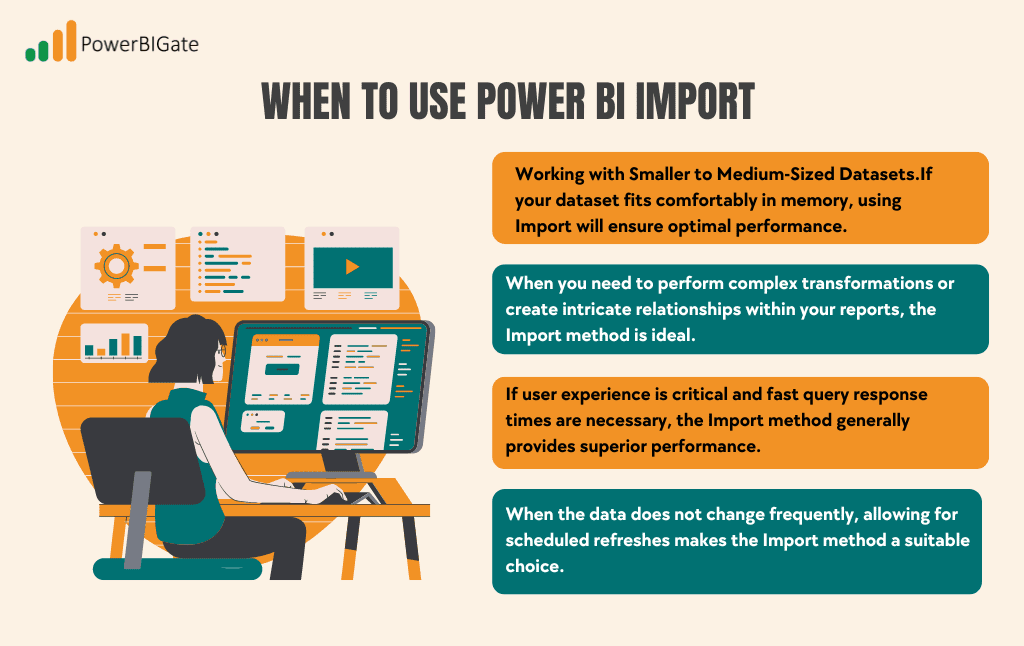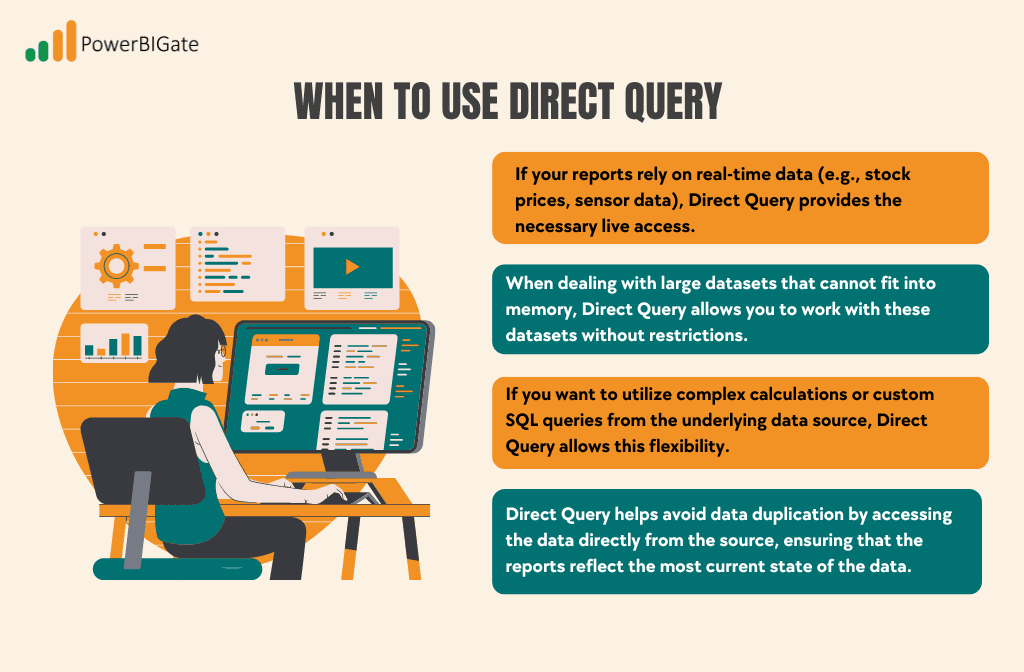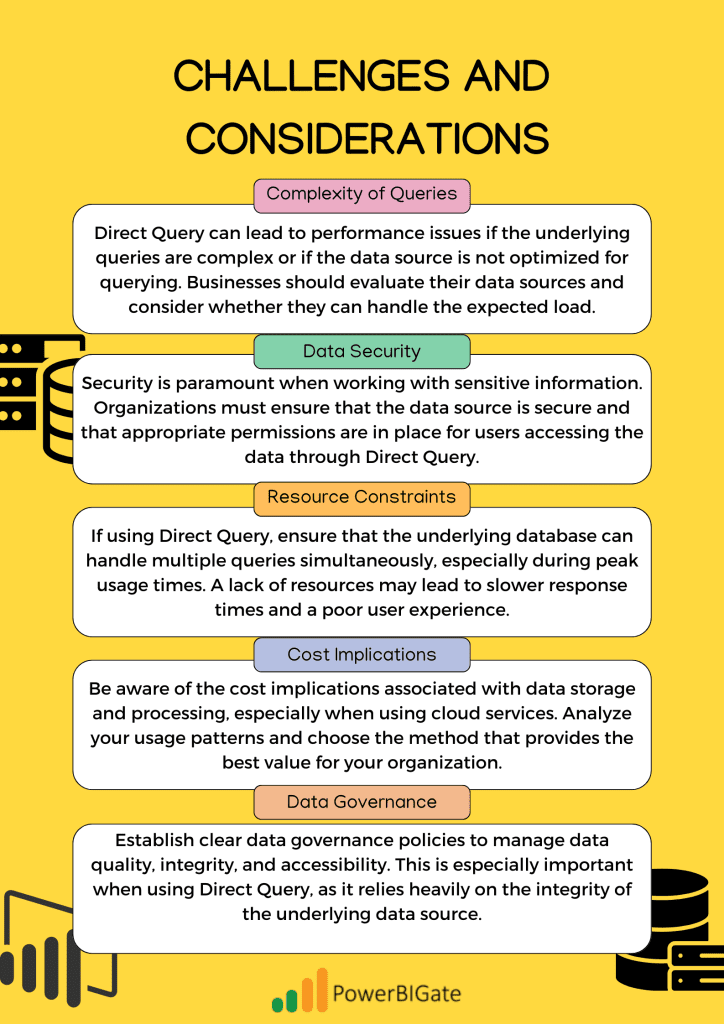In today’s data-driven world, the ability to analyze and report data effectively is crucial for any business. Microsoft Power BI is a leading business intelligence tool that provides various data connection methods, two of the most prominent being Import and Direct Query. Understanding the differences between these two modes is essential for optimizing your data analysis and reporting processes. Each method offers unique advantages and limitations, making them suitable for different scenarios. This article will delve into the intricacies of these connectivity modes, helping you make informed decisions based on your specific needs.
What is Power BI Import?
Power BI Import is a method that allows users to load data from various sources into Power BI Desktop. When data is imported, it is stored locally within the Power BI file, creating a snapshot that can be refreshed at scheduled intervals. This method is particularly popular for users who prioritize speed and performance in their reports.
Key Characteristics of the Import Method
- Data Storage:
- When using the Import method, the data is stored within the Power BI file. This allows for fast querying since the data is readily available in memory. The data is compressed and optimized for storage, enabling efficient retrieval.
- Example: A retail company that imports its sales data from various sources can create complex reports that respond instantly to user interactions because the data is pre-loaded.
- Performance:
- Since the data is stored locally, reports render quickly, providing a responsive user experience. Users typically experience significantly faster performance compared to Direct Query mode. For example, a sales report might take a few seconds to load with Import, while the same report could take much longer using Direct Query, especially if it involves complex aggregations.
- Analytical Insight: Users can utilize advanced DAX (Data Analysis Expressions) calculations on the imported data without worrying about real-time constraints, enhancing their ability to perform deep analysis.
- Data Transformation:
- Users can perform extensive data cleaning and transformation using Power Query before importing the data. This feature allows for sophisticated data modeling and preparation before analysis, making it easier to create calculated columns, measures, and data models that accurately reflect business needs.
- Practical Scenario: A finance team might use Power Query to merge datasets from different financial periods, remove duplicates, and calculate financial ratios before importing the final dataset.
- Limitations:
- The Import method has storage limits (e.g., 1GB per dataset in the Power BI service). It may not be suitable for very large datasets or those requiring real-time updates. For instance, a company that tracks millions of records daily might find the Import method inadequate for their reporting needs.
- Consideration: Organizations dealing with massive volumes of data need to strategize around data storage and refresh frequency to avoid hitting limits.

Use Cases for Power BI Import
The Import method is particularly effective in various business scenarios:
- Historical Data Analysis:
- Companies often analyze historical data to spot trends. For example, a manufacturing firm could import several years’ worth of production data to analyze efficiency improvements over time.
- Static Data Reporting:
- For organizations that generate periodic reports based on static data, Import allows for efficient data handling. A marketing team preparing quarterly performance reports can leverage the Import method to ensure fast load times for their dashboards.
- Complex Data Models:
- Businesses requiring intricate data models will benefit from the transformation capabilities offered by Power Query. An educational institution might import student performance data and use DAX to create models for analyzing trends across different academic years.
- Aggregated Reporting:
- Organizations that require aggregated reporting based on a set of data will find Import beneficial. A retail chain can aggregate sales data by region to provide insights to regional managers.
What is Direct Query?
Direct Query mode enables Power BI to connect directly to a data source without importing the data into Power BI. Instead, it queries the data in real-time as needed, making it an appealing option for scenarios requiring up-to-the-minute accuracy.
Key Features of Direct Query
- Real-Time Access:
- Direct Query provides live access to data, ensuring that reports always reflect the current state of the source system. This is particularly valuable for applications that rely on constantly changing data, such as financial markets or operational metrics.
- Example: A logistics company can utilize Direct Query to display real-time delivery statuses, ensuring their dashboard is always up to date with the latest information.
- No Storage Limits:
- Since data isn’t stored in Power BI, there are no restrictions on dataset size. This makes Direct Query suitable for scenarios where datasets exceed the memory limitations of the Import method.
- Real-World Implication: A telecommunications firm analyzing call records can access extensive datasets without worrying about the constraints of the Import method.
- Limited Data Transformation:
- Users can only perform limited transformations and calculations within Power BI. Most data transformations need to be handled in the source database or using custom SQL queries. This limitation requires a solid understanding of the underlying data structure.
- Challenge: Analysts must be familiar with SQL or the source system’s query language to extract and transform data effectively.
- Performance Variability:
- The performance of reports can vary significantly based on the complexity of queries and the capabilities of the underlying data source. Reports may take longer to render, especially if they involve complex calculations or aggregations.
- Strategic Insight: Users should consider the performance capacity of their data source when relying on Direct Query, particularly during peak usage times.

Use Cases for Direct Query
Direct Query is advantageous in several scenarios:
- Dynamic Data Reporting:
- Organizations needing up-to-the-minute data, such as stock trading platforms, will find Direct Query indispensable for providing accurate market data.
- Large, Unmanageable Datasets:
- Companies working with datasets too large to be handled via Import will benefit from Direct Query. An online service analyzing millions of transactions daily can maintain performance without importing data.
- Custom SQL Query Requirements:
- If your organization relies on complex calculations or joins that are best handled at the database level, Direct Query allows for this flexibility. A data engineer might leverage Direct Query to run sophisticated SQL queries for business intelligence reports.
- Single Source of Truth:
- Direct Query helps avoid data duplication by accessing the data directly from the source, ensuring that the reports reflect the most current state of the data. A bank monitoring transaction data needs this real-time access to maintain data integrity.
Key Differences Between Import and Direct Query
To better understand when to use each method, let’s explore their key differences in detail.
|
Feature |
Power BI Import |
Direct Query |
|
Data Storage |
Stores data locally |
Queries data directly from the source |
|
Performance |
Generally faster due to local storage |
Slower performance depending on source |
|
Data Refresh |
Requires manual or scheduled refreshes |
Provides real-time updates |
|
Data Volume Limitations |
Limited by storage capacity |
No limitations on dataset size |
|
Transformation Capabilities |
Extensive transformations allowed |
Limited transformations available |
|
Use Cases |
Best for smaller datasets with infrequent updates |
Ideal for large datasets or real-time needs |
When to Use Power BI Import
The Import method is typically recommended in several scenarios:
- Working with Smaller to Medium-Sized Datasets:
- If your dataset fits comfortably in memory, using Import will ensure optimal performance. For example, a retail company analyzing sales data from the past year would benefit from importing this data for quick, efficient reporting.
- Extensive Data Transformations:
- When you need to perform complex transformations or create intricate relationships within your reports, the Import method is ideal. A financial analyst might use Import to create a detailed sales forecast model that requires significant data manipulation.
- Fast Query Response Times:
- If user experience is critical and fast query response times are necessary, the Import method generally provides superior performance. A marketing team generating weekly performance dashboards would benefit from this speed.
- Data with Infrequent Changes:
- When the data does not change frequently, allowing for scheduled refreshes makes the Import method a suitable choice. For example, a historical analysis of quarterly sales data might only require updates every few months.

Example Case: Using Import Method
Consider a company that tracks its sales data weekly from various sources, including an ERP system. They can import this data into Power BI, performing extensive data transformations to analyze trends, create visuals, and derive actionable insights. This approach allows for fast reporting, which is essential for timely decision-making.
When to Use Direct Query
Direct Query should be considered in the following scenarios:
- Real-Time Access to Frequently Updated Data:
- If your reports rely on real-time data (e.g., stock prices, sensor data), Direct Query provides the necessary live access. A logistics company monitoring delivery statuses in real time would find this method indispensable.
- Large Dataset Size Exceeding Memory Capacity:
- When dealing with large datasets that cannot fit into memory, Direct Query allows you to work with these datasets without restrictions. A telecommunications firm analyzing millions of call records would benefit significantly from this approach.
- Leveraging Complex Calculations or Custom SQL:
- If you want to utilize complex calculations or custom SQL queries from the underlying data source, Direct Query allows this flexibility. A data engineer might write custom SQL queries to aggregate data from multiple tables in a database.
- Maintaining a Single Source of Truth:
- Direct Query helps avoid data duplication by accessing the data directly from the source, ensuring that the reports reflect the most current state of the data. A financial institution tracking live market data would prefer this method to maintain accuracy.

Example Case: Using Direct Query Method
Imagine a stock trading platform that needs to provide users with real-time stock prices. By using Direct Query, the platform can access live data from their database, ensuring that users always see the most current market information without the delay of data imports.
Combining Import and Direct Query
Power BI also allows users to combine both methods through Dual Storage Mode. This hybrid model can provide significant advantages:
- Benefits of Speed and Real-Time Information:
- Users can benefit from the speed of imported datasets while still accessing real-time information from other sources. For instance, a business might import historical sales data for analysis while using Direct Query to access real-time inventory levels.
- Complex Modeling Scenarios:
- It enables more complex modeling scenarios where certain datasets require frequent updates while others do not, allowing for more comprehensive analysis without sacrificing performance. A healthcare organization might import patient data while querying real-time admission stats directly.
Example Case: Combining Both Methods
A retail company could use the Import method for their historical sales data, allowing for deep analysis and trend identification while also using Direct Query for live inventory data. This approach would enable them to make data-driven decisions based on both past performance and current stock levels.
Challenges and Considerations
While both Import and Direct Query have their strengths, there are challenges and considerations that organizations must keep in mind when selecting the appropriate method.
- Complexity of Queries:
- Direct Query can lead to performance issues if the underlying queries are complex or if the data source is not optimized for querying. Businesses should evaluate their data sources and consider whether they can handle the expected load.
- Data Security:
- Security is paramount when working with sensitive information. Organizations must ensure that the data source is secure and that appropriate permissions are in place for users accessing the data through Direct Query.
- Resource Constraints:
- If using Direct Query, ensure that the underlying database can handle multiple queries simultaneously, especially during peak usage times. A lack of resources may lead to slower response times and a poor user experience.
- Cost Implications:
- Be aware of the cost implications associated with data storage and processing, especially when using cloud services. Analyze your usage patterns and choose the method that provides the best value for your organization.
- Data Governance:
- Establish clear data governance policies to manage data quality, integrity, and accessibility. This is especially important when using Direct Query, as it relies heavily on the integrity of the underlying data source.

Future Trends in Power BI Data Connectivity
As data analytics evolves, so do the methods and technologies behind data connectivity. Here are some future trends that organizations should be aware of:
- Enhanced Performance Optimization:
- Future versions of Power BI may include improved optimization techniques for Direct Query, making it faster and more efficient. This could reduce the performance gap between Import and Direct Query methods.
- Greater Integration with Cloud Services:
- With the growing reliance on cloud storage, Power BI is likely to continue enhancing its integration with various cloud services, making it easier to connect to multiple data sources and leverage cloud-based data processing.
- AI and Machine Learning Integration:
- The integration of AI and machine learning capabilities into Power BI will likely improve data analysis processes. This could enhance both Import and Direct Query methods by providing predictive analytics and automated insights.
- Real-Time Collaboration:
- As businesses increasingly focus on collaboration, future iterations of Power BI may offer more robust tools for real-time collaboration, allowing multiple users to work on reports simultaneously, regardless of the data connection method.
Conclusion
Choosing between Power BI Import and Direct Query depends largely on your specific requirements regarding performance, data volume, and refresh frequency. Understanding these differences will empower you to make better decisions for your analytics projects.
As you consider your options, reflect on your organization’s needs. Are you prioritizing speed and responsiveness, or real-time access to large datasets? Each method has its own strengths and weaknesses, making it essential to evaluate your business intelligence goals thoroughly.
Final Thoughts and Best Practices
- Evaluate Your Data Needs:
- Assess your organization’s data requirements, including the volume, refresh frequency, and access speed needed for your reports.
- Test Both Methods:
- If possible, test both methods with your data. This hands-on experience can provide valuable insights into which method works best for your specific use case.
- Stay Informed:
- Keep up to date with the latest Power BI features and enhancements. Microsoft frequently updates Power BI, introducing new capabilities that can affect how you manage data connections.
- Engage Stakeholders:
- Involve key stakeholders in the decision-making process. Understanding their needs and preferences can help you choose the most effective data connection method for your organization.
- Seek Expertise:
- If you’re uncertain about which method to choose, consider consulting with Power BI experts or data analysts who can provide tailored advice based on your organizational needs.
Community Engagement
What has been your experience with Power BI Import vs. Direct Query? Have you faced any challenges or successes using these methods? Share your thoughts and insights in the comments below! Engaging with peers can foster a community of learning and shared experiences, which is invaluable in the ever-evolving field of business intelligence.
